

This is a merged information page for Item #1057.
View normal product page.
Pololu item #:
1057
Brand:
Power HD
Status:
Discontinued at Pololu

The 1501MG is a metal-geared analog servo from Power HD that delivers extra-high torque normally associated with much more expensive or larger servos. This is one of our most popular standard-size servos. Servo horns and associated hardware are included.
Key specs at 6 V: 0.14 sec/60°, 240 oz-in (17 kg-cm), 60 g.
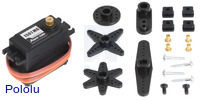 |
An example of hardware included with the Power HD high-torque servo 1501MG. Actual hardware might vary. |
|---|
 |
Metal gears and ball bearings of the Power HD high-torque servo 1501MG. |
|---|
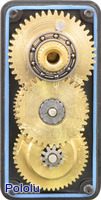 |
Metal gears and ball bearings of the Power HD high-torque servo 1501MG. |
|---|
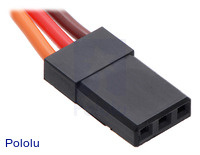 |
The servo cable is terminated with a Futaba-compatible JR-style connector. |
|---|
 |
Power HD 1501MG servo with Mounting Bracket for Standard-Size Servos. |
|---|
The HD-1501MG is a powerful standard-size servo that features metal gears and two ball bearings and can deliver a tremendous amount of torque for a servo this fast (if you need even more torque than this, check out the larger 1235MG giant servo). The 1501MG works with standard RC servo pulses, providing a running angle of approximately 165° over a servo pulse range of 800 µs to 2200 µs, and it has a 10″ (25 cm) cable that is terminated with a standard JR-style connector, which is Futaba-compatible. You can find more information about this servo under the specifications tab and in its datasheet (380k pdf).
|
|
This servo is also compatible with our Mounting Bracket for Standard-Size Servos:
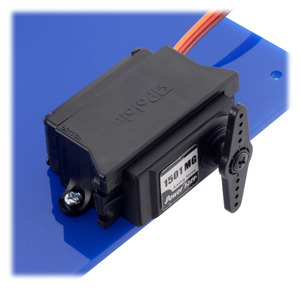 |
The pictures below show the metal gear train and ball bearings that help the servo deliver such high torque. Replacement gears for the 1501MG are available separately.
|
|
|
Note that, as with most hobby servos, stalling or back-driving this servo can damage it; we carry replacement gears for the 1501MG that can used in the event of gearbox damage. This servo can draw bursts of current in excess of 3 A at 6 V, so please make sure you have an appropriate power supply. For comparison, a typical standard-size servo might draw around an amp when straining.
The FS5115M high-torque servo from FEETECH is a lower-cost alternative to the 1501MG with nearly identical dimensions and similar performance. The two servos should be generally interchangeable for most applications. The picture below shows both the FS5115M and the 1501MG side by side:
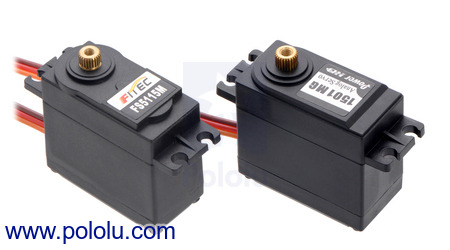 |
| Size: | 40.7 x 20.5 x 39.5 mm |
|---|---|
| Weight: | 60 g |
| Digital?: | N |
|---|---|
| Speed @ 6V: | 0.14 sec/60° |
| Stall torque @ 6V: | 17 kg·cm |
| Speed @ 4.8V: | 0.16 sec/60° |
| Stall torque @ 4.8V: | 15.5 kg·cm |
| Hardware included?: | Y |
| Lead length: | 10 in |
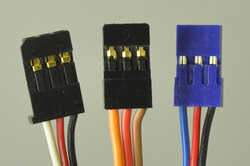 |
Most standard radio control (RC) servos have three wires, each a different color. Usually, they are either black, red, and white, or they are brown, red, and orange/yellow:
Please check the specs for your servo to determine the proper power supply voltage, and please take care to plug the servo into your device in the proper orientation (plugging it in backwards could break the servo or your device).
Note: Some of the servos we carry also have an optional fourth green wire that is separate from the three standard ones. This wire provides access to the feedback potentiometer, allowing you to directly measure the position of the output. The servos with this extra wire have "with Position Feedback" at the ends of their product names. The picture below is an example of such a servo.
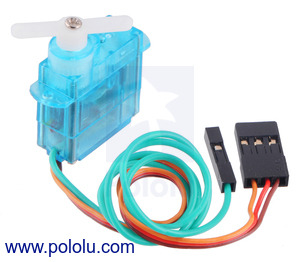 |
FEETECH Sub-Micro Servo FS0403-FB with Position Feedback. |
|---|
We do not specify the range of rotation of our servos because this information is not generally available from servo manufacturers. RC servos are usually intended for controlling things like the steering mechanism in an RC car or the flaps on an RC plane. Manufacturers make sure that the range is enough for these typical applications, but they do not guarantee performance over a wider range.
This means most RC servos will rotate about 90° using the standard 1–2 ms pulse range used by most RC receivers. However, if you are using a controller capable of sending a wider range of pulses, many servos can rotate through almost 180°.
You can find a servo’s limits if you use a servo controller that can send pulses outside of the standard range (such as our Maestro servo controllers). To find the limits, use the lowest possible supply voltage at which the servo moves, and gradually increase or decrease the pulse width until the servo does not move any further or you hear the servo straining. Once the limit is reached, immediately move away from it to avoid damaging the servo, and configure your controller to never go past the limit.
You might be wondering why we do not just follow the above steps for all the servos we carry and list a specification for degrees of rotation. Unfortunately, since servo manufacturers do not specify the range of rotation, it might change from one manufacturing run to the next. They will not inform us about changes that are not specified, and we have no way of knowing if or when they might change their manufacturing process.
For more information about servos and how to control them, we recommend the series of blog posts on servos starting with: Introduction to servos.
We added the FEETECH High-Torque Servo FS5115M to our expanding RC servo selection. This standard-size analog servo has a stall torque of 215 oz-in...
Pololu forum user Martin_H posted about his robot that plays the Tower of Hanoi with paper blocks. An RP5 chassis drives along a track, locating...
Anyone who has gone trick-or-treating has seen the house that puts a bowl of candy on the front porch and knows that there are those greedy...